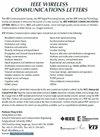有意义的目标:迈向语义功能率失真理论
IF 5.5
3区 计算机科学
Q1 COMPUTER SCIENCE, INFORMATION SYSTEMS
引用次数: 0
摘要
虽然语义通信已经成为一个活跃的研究领域,但统一的理论基础仍然是难以捉摸的。在这封信中,我们的目标是通过提供面向目标的语义率失真理论的新视角来部分填补这一空白。我们扩展了经典的速率失真模型,使其包含语义编码器和语义解码器,并定义了任务失真的可实现性。然后,我们定义了失真差异的新概念,并提供了一个与失真差异相关的速率失真函数的上界。在理论结果的基础上进行了实际实验,证明了在一定条件下的最佳性能。本文章由计算机程序翻译,如有差异,请以英文原文为准。
Meaningful Goals: Toward a Semantic-Functional Rate Distortion Theory
While semantic communication has become an active area of research, a unifying theoretical foundation remains elusive. In this letter, we aim to partly fill this gap by providing a new perspective on goal-oriented semantic rate distortion theory. We extend the classical rate distortion model to include a semantic encoder and decoder, and define achievability with respect to the task distortion. We then define the novel notion of distortion discrepancy, and provide a discrepancy-dependent upper bound on the rate distortion function. Practical experiments based on these theoretical results are provided, demonstrating optimal performance under certain conditions.
求助全文
通过发布文献求助,成功后即可免费获取论文全文。
去求助
来源期刊

IEEE Wireless Communications Letters
Engineering-Electrical and Electronic Engineering
CiteScore
12.30
自引率
6.30%
发文量
481
期刊介绍:
IEEE Wireless Communications Letters publishes short papers in a rapid publication cycle on advances in the state-of-the-art of wireless communications. Both theoretical contributions (including new techniques, concepts, and analyses) and practical contributions (including system experiments and prototypes, and new applications) are encouraged. This journal focuses on the physical layer and the link layer of wireless communication systems.
 求助内容:
求助内容: 应助结果提醒方式:
应助结果提醒方式:


